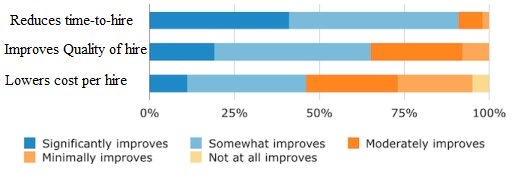Keeping with the adage "Time is money," organizations all over the world have been trying to minimize the time for various processes to maximize profits. One such process which can be optimized is the staffing function. The recovering economic condition in most countries has increased the number of hires.
According to the JOLTS- Job Openings and Labor Turnover Survey, five million people were hired in 2014. The first time hiring crossed the 5 million mark since 2007. This clearly shows that the need of the hour is a faster and improved recruitment cycle.
One of the most commonly used metric for evaluating the staffing function is Time to Hire. It is “usually measured in days and broadly reflects the total elapsed time required to staff an open position.” But despite its wide usage across organizations, recruiting time continues to be one of the poorly understood metrics in staffing. The reason being:
-
Time to hire is concerned only with the speed of hiring and not the quality of hire.
-
It has limited application as far as measuring staffing performance is concerned.
-
It is ineffective as far as measuring Staffing effectiveness is concerned.
-
Poorly defined and full of ambiguities.
-
There is no clear demarcation as to when the hiring time starts and when it ends.
-
Little or no distinction made between time to hire and time to fill.
Although the cons stated above raise questions about the time to hire metric, we cannot write it off immediately. The reason being it has been in use for a long time now and has stood the test of time.
Time to hire is still relevant because it helps measure recruiting efficiency and streamlines the effort. This is true especially if it is a direct sourcing strategy, calculating the present time in selecting candidates helps in bench-marking and process improvement.
Let’s take an example of company A after having recorded their initial time taken to hire, a period of say six months to one year is fixed when they try and improve on the metric using the adopted strategy. After the fixed period, the hiring time is calculated again to measure progress.
See: An Infographic on using Technology to Reduce Time to Hire
The role of technology may be an overused phrase but in today’s world, there’s absolutely no escape from it. The technological innovations in the past decade have transformed activities in every sphere of our lives.
The world of recruiting is fueled by time or lack thereof. Shortening recruiting time has always been an HR manager’s priority and would not only save the organization’s money but would also reduce the work load of mangers.
It is because of technology that people are more connected than ever. Talent communities and relationships are the keys to a successful candidate pipeline. Whether it is a referral platform, social media conversations or a company managed and operated community, the people make it a success.
It can be cumbersome for candidates to collect data manually to know about the company’s culture. They might lose interest, and it may take longer for employers to attract suitable candidates.
Engaging candidates over social media platforms like LinkedIn, Twitter and Facebook provide visual communication and candidates get to know more about the organization through rich media. Also, a list of relevant jobs on the company’s portal draws their interest and attention in the organization.
The rising trend of larger screen smartphones, fast mobile internet connectivity, and apps has mandated companies to have mobile-friendly career sites as candidates expect to be able to search, connect and engage with organizations via mobile devices.
Collecting paper resumes of candidates and their details can be a long and tiring process. Also, it leads to poor visibility of candidates, and they may miss out event heads. Internet job boards serve the purpose of both employers and job seekers to post jobs and resumes respectively.
Applicant tracking systems mean employers no longer need to process applications manually. The applicant tracking system will be able to dismiss unsuitable candidates with a fair degree of accuracy or look up for a candidate using a query within seconds.
Big data analytics can be hugely beneficial for helping employers to predict which candidates are best suited to a role. Cloud based products are used to extract and analyze information from more than 10 million candidates’ career histories to present a shortlist of individuals that meet all the criteria in seconds.
Video integration in the screening process removes the need for scheduling. Candidates can record the videos according to their suitability, which can be evaluated later by recruiters. This not only saves a recruiter’s time but is also convenient for candidates. Recruiters can spend more time evaluating more candidates rather than translating any candidate information noted during the screening.
Newer technologies are coming up with automated features that will help filter the candidate pool and provide selection tools like skills testing, background checks, drug screening, and behavioral assessments from one vendor, not four. The evolution in recruiting methods will help employers fill positions more quickly and enable them to build more meaningful relationships with candidates sooner. The empirical proof which clearly indicates that role of technology in hiring.

However, the tools, behaviors, expectations, and generations are changing all around us. It is up to us whether we view new technology as less of a complexity issue or more as an agent for positive change. Effectively using new technology will redefine a candidate’s recruitment experience and improve processes and outcomes for the organizations.



Leave a Reply